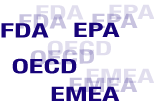Home » Our Services » Immunotoxicity
Immunotoxicity
The human immune system involves a complex set of cells and organs that can be adversely affected by drugs or chemicals. This results in increased susceptibility to infections, tumors, allergic responses, autoimmune reactions or other forms of immune system diseases. The assessment of immunotoxicity is, therefore, an important component of safety evaluation of chemicals and pharmaceuticals.
The international Immunotoxicity guideline ICH / EMA / FDA „S8 Immunotoxicity Studies for Human Pharmaceuticals“ has been in effect since May 2006. This and other recent guidelines from the EMA (1) and FDA/CDER (2) emphasize the need to investigate immunotoxic effects during the preclinical phase of drug development. Specific tests are recommend to measure immunotoxicity. According to the EMA guidelines „all new medical products should be tested for their immunotoxic potential“.

Comparable guidelines have been issued for the safety assessment of chemicals, food additives (3,4) or vaccines (5).
For general information please refer to „ Immunotoxicity and Immunogenicity – Upcoming Changes in the Preclinical Drug Approval Process“„.
vivo Science has validated and implemented a standardized two-tiered immunotoxicity testing protocol into its service portfolio which is in full compliance with international guidelines and recommendations. This two-tiered approach is described below
Additional information to the testing protocols is also available in Immunotoxicity Testing of Drugs and Chemicals.
Tier 1: Screening
Immunopathology
- Complete blood count and differential white blood cell count
- Lymphoid organ weights, body weight and temperature
- Histopathology, gross and microscopic examination of spleen, thymus, lymph nodes, Peyer’s patches and bone marrow
Humoral immunity
- Total serum protein, albumin,globulin ratio
- Immunoglobulin isotype distribution of IgM, IgG, IgA and IgE
- Total haemolytic complement activity
- Serum auto-antibody screen and deposition of immunoglobulins
Cell-mediated immunity
- Immuno-staining and flow-cytometric quantitation of spleen and lymph nodes for B cells and CD4+/CD8+ T cells
- Mitogen stimulation assays for B and T cells (spleen)
- Quantitation of resident peritoneal cells and phagocytic ability
Tier 2: Comprehensive testing
Humoral-mediated immunity
- Kinetic evaluation of humoral response to T-dependent antigen (primary and secondary responses using, for example, sheep red blood cells)
- Kinetic evaluation of primary humoral response to a T-independent antigen (primary response using, for example, bacterial polysaccharides)
Cell-mediated immunity
- Delayed-type hypersensitivity response to sheep red blood cells
- Mixed leukocyte response against allogeneic leukocytes (MLR)
- Cytotoxic T lymphocyte (CTL) cytolysis against allogeneic tumor cells
Host resistance challenge models using endpoints
- Syngeneic tumor cells – MethA fibrosarcoma for growth and regression and B16 melanoma for lung burden
- Bacterial models including Listeria monocytogenes or streptococcus species for mortality
- Viral models such as the cytomegalovirus for viral load in salivary gland, lung, kidney, spleen and liver
Tier 1 of our immunotoxicity assessment protocols can be implemented in a standard 28-day repeat dose toxicology study according to the guideline OECD 407 using either mice or rats.
An extension into Tier 2 is recommended when immunotoxicity is suggested from the data in the tier 1 tests or when the compound to be assessed is intended for an immunological application. The species of choice in the tier 2 studies is the mouse. Tier 2 requires the immunization/sensitization of additional experimental animals which are not included in a standard 28-days repeat dose toxicity study.
(1) Note for Guidance on Repeated Dose Toxicity, CPMP/SWP/1042/99 Repeated Dose Toxicity
(2) Guidance for Industry: Immunotoxicology Evaluation of Investigational New Drugs, October 2002. FDA guidance
(3) OECD Guidelines for Testing Chemicals: Repeated Dose Oral Toxicity-Rodent: 28 Day or 14 Day Study (Guideline 407) http://www.oecd.org/dataoecd/17/52/1948386.pdf
(4) Health Effects Test Guidelines, Immunotoxicity, OPPTS 870.7800 EPA guidance
(5) Note for Guidance on Preclinical Pharmacological and Toxicological Testing of Vaccines, CPMP/SWP/465/95 Preclinical Pharmacological and Toxicological Testing of Vaccines